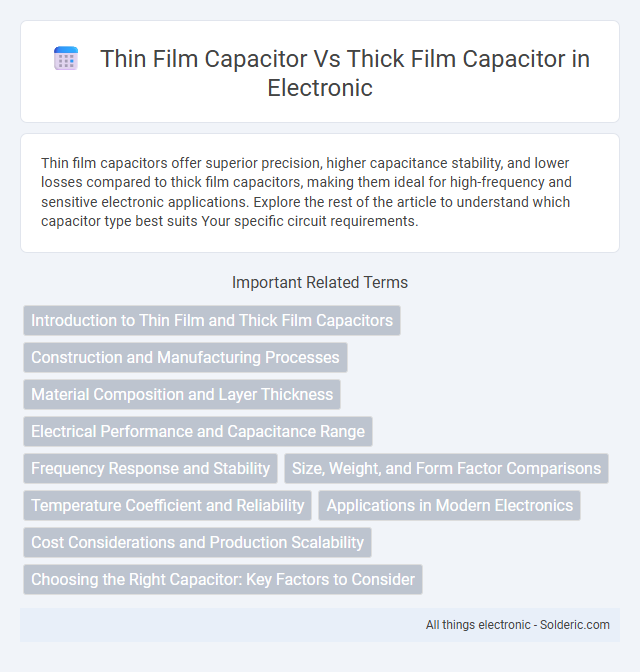Thin film capacitors offer superior precision, higher capacitance stability, and lower losses compared to thick film capacitors, making them ideal for high-frequency and sensitive electronic applications. Explore the rest of the article to understand which capacitor type best suits Your specific circuit requirements.
Comparison Table
| Feature | Thin Film Capacitor | Thick Film Capacitor |
|---|---|---|
| Dielectric Material | Thin dielectric layers deposited by vapor or sputtering | Thicker dielectric layers applied by paste and firing processes |
| Capacitance Range | Low to medium (pF to nF range) | Medium to high (nF to mF range) |
| Tolerance | +-1% to +-5% | +-5% to +-20% |
| ESR (Equivalent Series Resistance) | Low ESR, suitable for high-frequency applications | Higher ESR, better for general-purpose uses |
| Voltage Rating | High voltage tolerance (up to hundreds of volts) | Moderate voltage tolerance |
| Temperature Stability | Excellent, stable across wide temperature ranges | Moderate, less stable at extremes |
| Size | Compact, thin profile | Generally larger |
| Cost | Higher cost due to complex manufacturing | Lower cost, easier mass production |
| Typical Applications | High-frequency circuits, precision electronics, RF filters | Power supplies, general electronics, decoupling |
Introduction to Thin Film and Thick Film Capacitors
Thin film capacitors use a very thin dielectric layer, typically less than a micron, enabling high precision, low losses, and superior high-frequency performance compared to thick film capacitors. Thick film capacitors have a dielectric thickness ranging from several microns to tens of microns, offering higher capacitance values but with increased tolerance and lower frequency response. Applications demanding miniaturization and stability often favor thin film technology, while thick film capacitors are commonly used where cost-effective, larger capacitance is sufficient.
Construction and Manufacturing Processes
Thin film capacitors are constructed using a vacuum deposition or sputtering process to create ultra-thin dielectric and electrode layers, resulting in high precision and stability. Thick film capacitors utilize screen printing of dielectric paste and fired electrodes on ceramic substrates, which allows for cost-effective mass production and robust mechanical strength. Choosing between these depends on your need for miniaturization and electrical performance versus manufacturing scalability and durability.
Material Composition and Layer Thickness
Thin film capacitors utilize a dielectric layer composed of high-purity materials such as silicon dioxide or tantalum pentoxide, with layer thicknesses typically in the range of a few micrometers, enabling precise capacitance control and high-frequency performance. In contrast, thick film capacitors employ ceramic or glass-based dielectric materials applied in layers several micrometers to several hundreds of micrometers thick, providing higher capacitance values but with increased parasitic inductance. Understanding these differences in material composition and layer thickness helps you select the optimal capacitor type for applications requiring specific electrical characteristics and miniaturization.
Electrical Performance and Capacitance Range
Thin film capacitors offer superior electrical performance, featuring low equivalent series resistance (ESR) and inductance, enabling high-frequency applications and stable capacitance over a broad temperature range. Thick film capacitors typically provide higher capacitance values but exhibit greater ESR and reduced frequency response, making them suitable for general-purpose and power electronics. Your choice depends on the need for precision and high-frequency efficiency in thin films or the requirement for larger capacitance in thick film capacitors.
Frequency Response and Stability
Thin film capacitors exhibit superior frequency response and stability due to their low equivalent series resistance (ESR) and inductance, enabling efficient performance in high-frequency applications. Thick film capacitors, while more robust and cost-effective, tend to have higher ESR and dielectric losses, which can limit their effectiveness at elevated frequencies and over extended temperature ranges. For applications demanding precise and stable capacitance under rapid signal changes, thin film capacitors provide significant advantages in maintaining Your circuit's performance integrity.
Size, Weight, and Form Factor Comparisons
Thin film capacitors typically offer smaller size and lighter weight compared to thick film capacitors due to their ultra-thin dielectric layers and compact construction. The silicon-based substrates and precise deposition techniques in thin film capacitors enable ultra-miniaturized form factors essential for high-frequency, space-constrained applications. Thick film capacitors, constructed from screen-printed ceramic or metal oxide films on larger substrates, tend to have bulkier dimensions and higher mass, limiting their suitability for compact electronic designs.
Temperature Coefficient and Reliability
Thin film capacitors exhibit superior temperature coefficient stability, maintaining capacitance within tight tolerances over a wide temperature range, making them ideal for precision applications. Thick film capacitors generally have higher temperature coefficients, leading to greater capacitance variation with temperature fluctuations, which can impact circuit reliability. Your choice between thin and thick film capacitors should consider the required temperature performance and long-term reliability in your electronic design.
Applications in Modern Electronics
Thin film capacitors offer superior precision and stability, making them ideal for high-frequency circuits, RF communication devices, and aerospace applications where low noise and high reliability are critical. Thick film capacitors excel in power electronics, automotive systems, and industrial machinery due to their robustness and ability to handle higher voltages and larger capacitance values. Your choice between thin film and thick film capacitors should consider the specific performance requirements and operating conditions of your electronic application.
Cost Considerations and Production Scalability
Thin film capacitors typically incur higher production costs due to complex fabrication processes involving vacuum deposition techniques, making them less economical for large-scale manufacturing. Thick film capacitors offer cost advantages with simpler screen-printing methods that enable efficient mass production, resulting in lower unit costs. Your choice depends on balancing budget constraints against performance needs, with thick film capacitors favored for scalable, cost-effective applications.
Choosing the Right Capacitor: Key Factors to Consider
Selecting between thin film and thick film capacitors depends primarily on required capacitance stability, frequency response, and operating environment. Thin film capacitors offer superior precision, lower ESR, and excellent performance at high frequencies, making them ideal for RF and filtering applications. Thick film capacitors provide cost-effective solutions with higher capacitance values and better power handling, suitable for general-purpose circuits and power electronics.
thin film capacitor vs thick film capacitor Infographic

 solderic.com
solderic.com